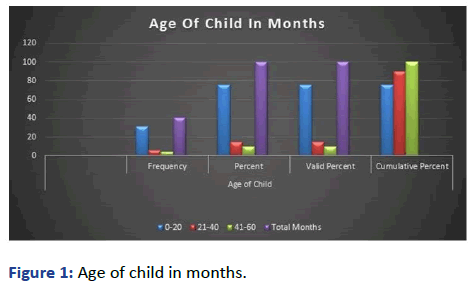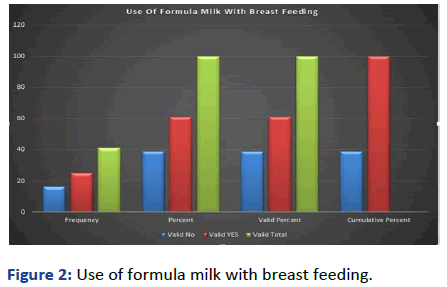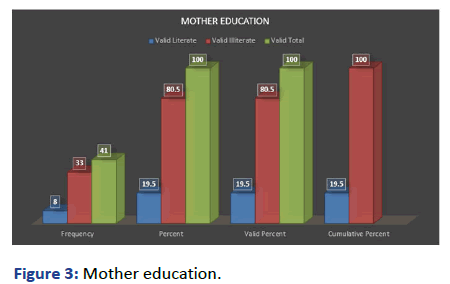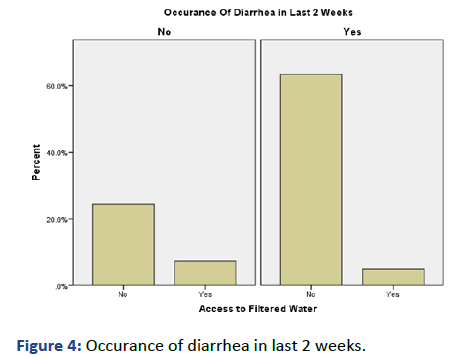Research Article - (2024) Volume 9, Issue 3
Evaluation of Factors Associated with Malnutrition under 5 Year Old Children in DHQ Hospital Sahiwal
Shahbaz Bashir*,
Baber Khan,
Arslan Khalid,
Hafiza Iqra Faryad,
Hafiza Arooj Fatima and
Wara Saeed
Department of Medicine, Sahiwal Medical College, Sahiwal, Pakistan
*Correspondence:
Shahbaz Bashir, Department of Medicine, Sahiwal Medical College, Sahiwal,
Pakistan,
Email:
Received: 23-Aug-2019, Manuscript No. IPPHR-24-1582;
Editor assigned: 28-Mar-2019, Pre QC No. IPPHR-24-1582 (PQ);
Reviewed: 11-Sep-2019, QC No. IPPHR-24-1582;
Revised: 21-Jun-2024, Manuscript No. IPPHR-24-1582 (R);
Published:
19-Jul-2024, DOI: 10.35841/2472-1646.9.02.11
Abstract
Background: Malnutrition is a serious child health issue throughout the developing world. Pakistan has the second highest infant and child mortality rate in South Asia. This study was carried out to assess the factors of malnutrition under 5 years of age children and to determine the frequency and association of malnutrition with various demographic variables in the study group.
Methods: A cross sectional study was conducted at the PAEDS ward and OPD of the DHQ hospital Sahiwal during July-August 2017. Malnourished children of under 5 years of age without confirmed diagnosis of any disease/ailment were included. Guardians of 41 children were interviewed using a structured questionnaire. Demographic variables include age, gender, family size, family income, breastfeeding, maternal education and presence of siblings under 5 years in family. Weight (kg) was measured and malnutrition was assessed by weight for age.
Results: Our study indicated malnutrition to be significantly associated with child age, use of formula milk, occurrence of diarrhea, mother illiteracy and lack of access to filtered water. No significant association was found between malnutrition and gender, family size, family income, breast feeding and presence of siblings under 5 years of age.
Conclusion: There is a need to plan composite interventions to elucidate the factors that place children at greater risk for malnutrition.
Keywords
Malnutrition; Child nutrition; Child nutrition disorders; Child nutritional status; Infant
nutrition disorders
Introduction
World Food Programme (WFP) defines malnutrition as “A
state in which the physical function of an individual is
impaired to the point where he or she can no longer maintain adequate bodily performance process such as growth,
pregnancy, lactation, physical work and resisting and
recovering from disease [1].”
•Malnutrition is a serious child health issue throughout the
developing countries and the cause of approximately 50%
of the 10.7 million deaths each year among under-five
children in the developing world.
• The lancet series on maternal and child under nutrition
(2008) reported that 20% of underweight children younger
than 5 belonged to low and middle income countries.
• After India (39%) and Bangladesh (5.7%), Pakistan (5.5%)
contributes the third largest share of under-weight
children in the world.
• Malnutrition has a complex etiology related to several
factors that alter the nutritional status of a child at varying
levels. It should be kept in mind that malnutrition is totally
a preventable pandemic provided that the risk factors
involved are identified and combated at an early stage of
child growth.
Keeping in view, this study was conducted with an objective to
assess the factors of malnutrition of children <5 years of age
and to determine the frequency and association of
malnutrition with various demographic variables in those
children [2].
The conclusions drawn from the study can be used for
creating a conductive environment at local level by
eliminating those risk factors. At the national level, this could
be used to mobilize opinion leaders and decision makers.
The study is expected to enrich the existing body of research
and may herald further research aiming at defining linkage
between under five malnutrition and various demographic
variables [3].
Materials and Methods
This was a cross-sectional study conducted at the PAEDS ward
and OPD of DHQ hospital Sahiwal during July-August 2017.
The study population comprised of children presenting to the
OPD and PAEDS wards of district headquarter hospital
Sahiwal.
The general health status of children was assessed by taking a
detailed history from their parents/guardians. Malnourished
children, under-five years of age, without confirmed diagnosis
of any disease were included in the study. All children either
greater than five years of age or diagnosed with severe illness
were excluded [4].
A pre-tested questionnaire was used to collect information
from the guardians of the children after taking their informed
oral consent. Questionnaire was consist of 36 questions
containing demographic variables to identify individual
factors, family factors and socioeconomic or environment
factors as predicted in referential studies include like age,
gender, family size, family income, breastfeeding, maternal
education, the presence of siblings <5 years of age in the
family. Weights (kg) of the children were measured using
standard measuring devices in PEADS ward and OPD [5].
The World Health Organization (WHO) classification of
weight-for-age (W/A) index was used to assess the nutritional status of the children. Underweight, based on weight-for-age,
is a composite measure of stunting and wasting and is
recommended as the indicator to assess changes in the
magnitude of malnutrition over time.
The nutritional status of children in our study population is
compared with the WHO child growth standards. The data
was entered and analyzed using Statistical Package for Social
Sciences (SPSS) version 22. Weight-for-age (W/A) were
calculated using WHO weight/age graph for girls and boys [6].
Results
A total of 41 subjects were included in this study comprising
20 males and 21 females with a mean age of 20.31 months
ranging from 0-60 months. All the participants were
malnourished as we compared their current weights with
WHO W/A standard charts.
Findings of factors and their frequencies and relations
associated with malnutrition are displayed below.
The frequency of malnutrition was highest in the 0-20 months
(75.6%) age group and was comparatively lower in other
groups. No significant association was found between
malnutrition and gender. It occurred with the same frequency
in both males and females [7].
A statistically significant relationship was established between
maternal education and malnutrition in our study. The
frequency of malnutrition was higher in the children whose
mothers had no or very little education (80.5% children’s
mothers were illiterate).
Our study indicates that those families which don’t have
access to filtered water, their child’s suffer more from
diarrhea and are malnourished. This is an important factor of
malnourishment in children under 5 at DHQ hospital Sahiwal.
Our study also gives the statistical relation between
malnourishment and use of formula milk (Dabba Dodh) as
compensation of mother milk [8].
No significant association was found between malnutrition
and family size, family income, breastfeeding, age of weaning
and presence of siblings <5 years of age in the family (Figures
1-4) (Tables 1-3).

Figure 1: Age of child in months.
| |
Frequency |
Percent |
Valid percent |
Cumulative percent |
| 0-20 months |
31 |
75.6 |
75.6 |
75.6 |
| 21-40 months |
6 |
14.6 |
14.6 |
90.2 |
| 41-60 months |
4 |
9.8 |
9.8 |
100 |
| Total |
41 |
100 |
100 |
|
Table 1: Age of child.

Figure 2: Use of formula milk with breast feeding.
| |
Frequency |
Percent |
Valid percent |
Cumulative percent |
| Valid |
No |
16 |
39 |
39 |
39 |
| Yes |
25 |
61 |
61 |
100 |
| Total |
41 |
100 |
100 |
|
Table 2: Use of formula milk with breast feeding.

Figure 3: Mother education.
| |
Frequency |
Percent |
Valid percent |
Cumulative percent |
| Valid |
Literate |
8 |
19.5 |
19.5 |
19.5 |
| Illiterate |
33 |
80.5 |
80.5 |
100 |
| Total |
41 |
100 |
100 |
|
Table 3: Mother education.

Figure 4: Occurance of diarrhea in last 2 weeks.
Discussion
Worldwide, malnutrition is an underlying cause of death for
2.6 million children each year. To combat such a high mortality
rate, a vigilant identification and comprehension of each
factor influencing malnutrition is required. To our knowledge,
this is probably the first study to recognize the associated
factors of under-five malnutrition in PEADS ward and OPD of
DHQ hospital Sahiwal [9].
Our study was conducted in July-August 2017. According to
Pakistan Panel Household Survey (PPHS-2010) micro-data,
56.9% children were adequately nourished, 15.7% were
moderately malnourished and 23.7% were severely
malnourished, whereas in our study we took only
malnourished child and did not categorized them into
moderate or severe categories to avoid complication of data.
In the first place, according to a study conducted in Iran
(2011), male gender was considered as a protective factor
against malnutrition, whereas, females were found to be
more strongly related to under-nutrition, however, as per a
study from Luangprabang province, Laos, males were more
likely to be underweight [10].
On the other hand, in our findings, gender is not a key
indicator of malnutrition. Secondly, our study has shown that
the frequency of malnutrition was highest in the age group of
0-20 months as compared to remaining age groups.
Conversely, a study of Oromia indicated children aged 48-59
months as the important factor of malnutrition.
A similar study conducted in Sialkot found the highest
proportion of malnourished children in 13-36 months age
group. This demands further research to probe if this is a
high-risk group in our population. Furthermore, poverty and
nutritional status of the child are not the directly correlating
factors in this study, a finding consistent with a similar study
carried out in India. In addition to that, previous studies have
suggested malnutrition to be significantly associated with
breastfeeding.
Whereas this factor remained insignificant in our study
contrary to previous results. Moreover, Bahawaluddin J, et al.
concluded in 2012 that the maternal illiteracy plays a major
contributing role to child malnutrition [11].
Another study in Ludhiana found 40.7% cases of malnutrition
associated with maternal illiteracy. Identically, our results also
established a statistically significant association between
malnutrition and maternal education and found 85.5% cases
of malnutrition associated with maternal illiteracy.
Similarly, Henry FJ, et al. stated an increased risk of
malnutrition among children with siblings under-five years old.
Our results also identified a comparatively higher
percentage of malnourished children in families having more
than 1 child under 5 years of age [12].
However, this result was not statistically significant. The
specific objectives of this study target child-survival and wellbeing.
These have been a focus of public health communities
for over last two decades. Unfortunately, they still remain an
important issue in a developing country like Pakistan. This is
reflected in United Nations Millennium Development Goals 4
(MDG 4) and 1 (MDG 1).
MDG 4 sets its targets (from 1990 to 2015) as a reduction in
under-five mortality by two-thirds and MDG 1 as a reduction
in prevalence of under-weight children by half. According to
the United Nations Development Programmes (UNDP) report
in Pakistan, progress on all indicators is lagging in MDG 1.
Progress on MDG 4, in all but 1 target, is also off track.
Currently, Pakistan stands among the worst in child and infant
mortality. The child mortality rate has only marginally
decreased, from 117 per thousand live births in 1990-91 to 94
per thousand in 2006-07.
The performance of Pakistan in achieving these goals is
severely lagging and it is likely to miss them. The need, of
measuring progress towards meeting these goals, has always
been strongly felt by public health professionals and policy
makers. Our study has tried to help satisfy this need by
developing a better understanding of the individual
contribution of each factor towards malnutrition.
This may go a long way in strengthening the impact of the
child nutritional programmes in whole Pakistan and also in
Sahiwal. Some of the limitations of this study need to be
noted. The sample size of this study was small due to limited
resources and time. In this regard, a community-based survey
with large sample, including the children visiting the private
setup in addition to public facilities is strongly recommended
in the future [13].
Conclusion
Children are the most vulnerable members of the society and
to allow their development to be affected by poor nutrition is
a waste of human potential.
This research study would be of little value if the assessment is
not followed-up by policy actions, which are most likely to
have the greatest impact on child malnutrition if directed at
an early stage of child growth. In order to attain better
nutritional outcomes for their children, women must be
educated beyond primary school level. Moreover, offering
frequent nutritional education programs can also be
beneficial to the mothers, particularly those with no or very
little education.
The local Government of Sahiwal should provide filtered
water in localities of Sahiwal and an appropriate surveillance
system should be devised for prompt and timely diagnosis of
malnutrition in children and its management at PEADS ward
DHQ hospital Sahiwal.
Acknowledgement
We are extremely thankful to Dr. Hassam Reham (Assistant
professor community medicine, research unit, Sahiwal
medical college) for data overview and for his continuous
support, guidance and thoughtfulness throughout the
research period.
Author’s Contributions
Baber Khan: Study conception and design, acquisition of data
and interpretation of data.
Shahbaz Bashir: Drafting of manuscript, analysis of data and
final approval of the version to be published.
Arslan Khalid: Drafting of questionnaire and acquisition of
data.
Hafiza Arooj Fatima, Hafiza Iqra Faryad and Wara Saeed: Drafting of questionnaire and acquisition of data.
References
- Mengistu K, Alemu K, Destaw B (2013) Prevalence of malnutrition and associated factors among children aged 6-59 months at Hidabu Abote district, North Shewa, Oromia regional state. J Nutr Disorders Ther. 1(1):2161-509.
[Google Scholar]
- Masood-Us-Syed SS, Saleh M, Butt ZK (2011) Nutritional assessment of children under the age of sixty months in district Sialkot, Pakistan. J Pioneer Med Sci. 1(1):7.
[Google Scholar]
- Mohseni M, Aryankhesal A, Kalantari N (2017) Factors associated with malnutrition among under five-year-old children in Iran: A systematic review. Ann Trop Med Public Health. 10(5).
[Google Scholar]
- Poda GG, Hsu CY, Chao JC (2017) Factors associated with malnutrition among children< 5 years old in Burkina Faso: Evidence from the demographic and health surveys-IV 2010. Int J Health Care Qual Assur. 29(7):901-908.
[Crossref] [Google Scholar] [PubMed]
- Chagas DC, Silva AA, Batista RF, Simoes VM, Lamy ZC, et al. (2013) Prevalence and factors associated to malnutrition and excess weight among under five year-olds in the six largest cities of Maranhao. Rev Bras Epidemiol. 16(1):146-156.
[Google Scholar] [PubMed]
- Obasohan PE, Walters SJ, Jacques R, Khatab K (2020) Risk factors associated with malnutrition among children under-five years in sub-Saharan African countries: a scoping review. Int J Environ Res Public Health. 17(23):8782.
[Crossref] [Google Scholar] [PubMed]
- Fernandes EC, Castro TG, Sartorelli DS (2017) Associated factors of malnutrition among African children under five years old, Bom Jesus, Angola. Rev Nutr. 30(1):33-44.
[Google Scholar]
- Vitolo MR, Gama CM, Bortolini GA, Campagnolo PD, Drachler MD (2008) Some risk factors associated with overweight, stunting and wasting among children under 5 years old. J Pediatr. 84(3):251-257.
[Crossref] [Google Scholar] [PubMed]
- Mohseni M, Aryankhesal A (2020) Developing a model for prevention of malnutrition among children under 5 years old. BMC Health Serv Res. 20(1):1-9.
[Crossref] [Google Scholar] [PubMed]
- Sahu SK, Kumar SG, Bhat BV, Premarajan KC, Sarkar S, et al. (2015) Malnutrition among under-five children in India and strategies for control. J Nat Sci Biol Med. 6(1):18.
[Crossref] [Google Scholar] [PubMed]
- Asfaw M, Wondaferash M, Taha M, Dube L (2015) Prevalence of undernutrition and associated factors among children aged between six to fifty nine months in Bule Hora district, South Ethiopia. BMC Public Health. 15:1-9.
[Crossref] [Google Scholar] [PubMed]
- Nhampossa T, Sigauque B, Machevo S, Macete E, Alonso P, et al. (2013) Severe malnutrition among children under the age of 5 years admitted to a rural district hospital in southern Mozambique. Public Health Nut. 16(9):1565-1574.
[Crossref] [Google Scholar] [PubMed]
- Asra M, Lin X, Haq IU, Pasha AB, Shao Y, et al. (2020) Malnutrition associated factors on children under 5 years old in Lhaviyani Atoll, Maldives. J Biomed Res. 34(4):301.
[Crossref] [Google Scholar] [PubMed]
Citation: Bashir S, Khan B, Khalid A, Faryad HI, Fatima HA, et al. (2024) Evaluation of Factors Associated with Malnutrition under
5 Year Old Children in DHQ Hospital Sahiwal. Pediatr Health Res. 9:11.
Copyright: © 2024 Bashir S, et al. This is an open-access article distributed under the terms of the Creative Commons Attribution
License, which permits unrestricted use, distribution, and reproduction in any medium, provided the original author and source
are credited.




